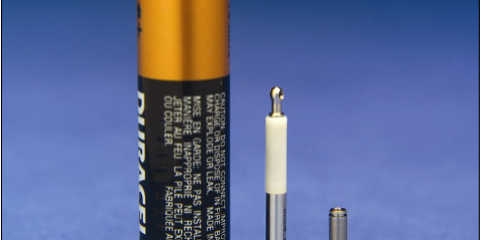When soldiers depart on long patrols, the gear they carry weighs up to 100lbs. Deployable communication devices such as radios, GPS, and night-vision goggles require the use of batteries in order to function. Batteries, along with water, contribute to 60-90 percent of the weight a soldier carries. [1] Because of this, the Department of Defense (DoD) has a particular interest in lightweight, long-lasting batteries. Developing lightweight battery technology can result in lessening the burden of soldiers by lightening the load or allowing them to carry additional items.
Research in micro-electronics has evolved to encompass energy storage systems that include miniature or micro-batteries. Micro-batteries are created by using a large electrode surface area and a short diffusion path in a planar battery structure; these characteristics are essential for improved performance. Consequently, thin-film electrodes and batteries with ultra-small gap anode and cathode have been designed and fabricated. Sophisticate silicon-based microfabrication technologies, including microelectromechanical systems (MEMS) processes, have been applied to produce miniature batteries. However, the cost and labor involved in manufacturing these batteries are prohibitively expensive, and further development of battery micro-systems is required to keep up with the increasing needs for miniature energy systems. RF tags, smart cards, ultra-thin watches, portable health monitoring devices, and other communication devices used by the military currently utilize micro-battery technology.
Scientists have been experimenting with different manufacturing techniques to reduce the expense of manufacturing micro-batteries. Researchers at Case Western Reserve University created a zinc-alkaline miniature planar structure primary battery using thick film screen printing technology. [2] This process utilizes MnO2 as the catalyst for the cathodic reduction, zinc as the anodic electrode and silver as the current collector. All of three of the components were generated by screen printing using thick film inks.
The cathode printing materials are another unique feature of this research. The materials were produced by using a Teflon-coated filter paper substrate printed on a thick film. This technique allows O2 in the air to diffuse through the micro-battery but inhibits any moisture penetration, enabling the appropriate oxygen reduction cathodic reaction. A paper saturated with a solution of KOH and ZnO is placed on top of the cathode followed by the zinc anode thick film aluminum that is added on top of the separator.
The overall process is a layer-by-layer addition manufacturing process, creating a practical and cost-effective technique for producing miniature batteries. In recent years, advancements in 3-D printing technology have provided attractive technology for packaging miniature batteries. Using standard computer-aided design tools and selected suitable polymeric or other packaging materials, 3-D printing technology can be utilized to package the micro-batteries in any shape and size. This platform can also be adopted to manufacture any micro-electronic device because the substrates are flexible, supporting dynamic batteries depending on use.
References
[1] Bargmann, J. (2014). A lighter, better pack to power our troops. Popular Mechanics.
[2] Ghiurcan, G.A., Liu, C.C., Webber, A., & Feddrix, F.H. (2003). Development and characterization of a thick-film printed zinc-alkaline battery. Journal of the Electrochemical Society, 150 (7), A922-A927.


